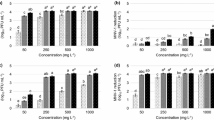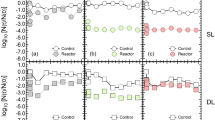Summary
Metallic aluminum has been studied for possible use in conjunction with or as an alternative to conventional soluble disinfectants as applied to drinking and wastewater. Acid-washed aluminum was incubated with [35S]methionine-labeled poliovirus type 1 (LSc) and the counts per min (cpm)/plaque-forming units (pfu) ratio was determined. After 2 h, only 0.013% of the cpm remained in solution, indicating viral adsorption onto the surface of the aluminum. After 76 h, 93% of the cpm returned to solution, while infectivity dropped from 2.2×107 pfu/ml to undetectable levels. This suggests that infectious viruses were adsorbed onto the aluminum surface and released from the surface of the aluminum as non-infectious particles. Analysis by electron microscopy, cesium chloride gradient and polyacrylamide gel electrophoresis indicates that either dissociation or destruction of the viral capsid proteins occurs during incubation with aluminum, which results in viral inactivation.
Similar content being viewed by others
References
Bitton, G., O. Pancorbo and G. Gifford. 1976. Factors affecting the adsorption of poliovirus to magnetite in water and wastewater. Water Res. 10: 973–980.
Bohn, H.L., B.L. McNeal and G.A. O'Conner. 1979. Soil Chemistry, 200 pp. John Wiley and Sons, New York.
Gerba C.P. 1983. Virus survival and transport in groundwater. Soc. Ind. Microbiol. 24: 247–251.
Hogle, J.M., M. Chow and D.J. Filman. 1985. Three-dimensional structure of poliovirus at 2.9 angstrom resolution. Science 229: 1358–1365.
Lippy, E.C. and S.C. Waltrip. 1984. Waterborne disease outbreaks-1946–1980: a thirty-five-year perspective. J. Am. Water Works Assoc. 76: 60–67.
Melnick, J.L., H.A. Wenner and C.A. Phillips. 1979. Enteroviruses. In: Diagnostic Procedures for viral, Rickettsial and Chlamydial Infections (Lennette, E.H. and N.J. Schmidt, eds.), 5th Edn., pp. 471–534, American Public Health Association, Washington, DC.
Miller, M.F., II. 1974. Particle counting of viruses. In: Principles and Techniques of Electron Microscopy: Biological Applications, Vol. 4 (Hayat, M.A., ed.), pp. 89–128, Nostrand Reinhold Co., New York.
Murray, J.P. 1980. Physical chemistry of virus adsorption and degradation on inorgranic surfaces. Its relation to waste-water treatment. U.S. EPA-600/2-80-134.
Rose, J.B., C.P. Gerba, S.N. Singh, G.A. Toranzos and B. Keswick. 1986. Isolation of viruses from finished water. J. Am. Water Works Assoc. 78: 56–61.
Thurman, R.B. and C.P. Gerba. 1987. Protecting ground-water from viral contamination. Environ. Sci. Eng., in press.
Westwood, J.C.N. and S.A. Sattar. 1976. The minimal infective dose. In: Viruses in Water (Berg, Bodily, Lennette Melnick and Metcalf, eds.), pp. 61–69, American Public Health Association, Washington, DC.
Author information
Authors and Affiliations
Rights and permissions
About this article
Cite this article
Thurman, R.B., Gerba, C.P. Characterization of the effect of aluminum metal on poliovirus. Journal of Industrial Microbiology 3, 33–38 (1988). https://doi.org/10.1007/BF01569440
Received:
Revised:
Accepted:
Issue Date:
DOI: https://doi.org/10.1007/BF01569440




